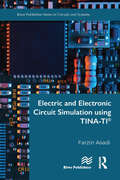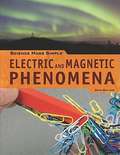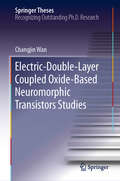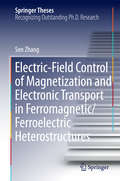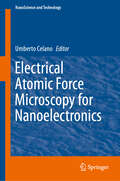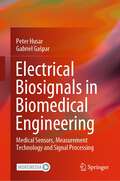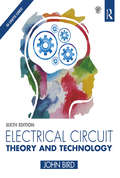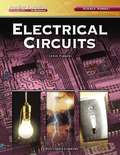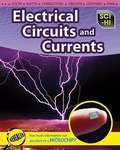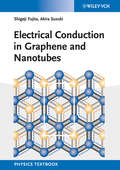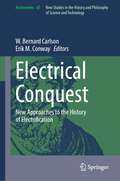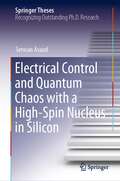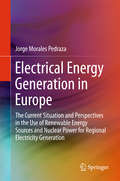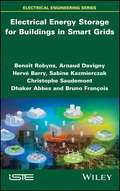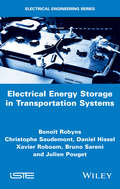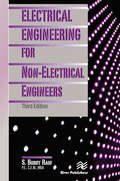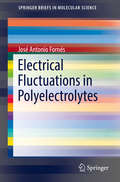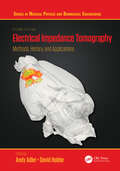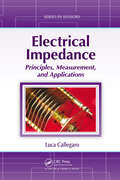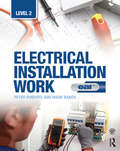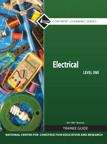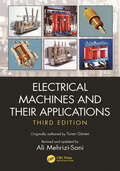- Table View
- List View
Electric and Electronic Circuit Simulation using TINA-TI®
by Farzin AsadiA circuit simulator is a computer program that permits us to see circuit behavior, i.e. circuit voltages and currents, without making the circuit. Use of a circuit simulator is a cheap, efficient, and safe way to study the behavior of circuits. The Toolkit for Interactive Network Analysis (TINA®) is a powerful yet affordable SPICE based circuit simulation and PCB design software package for analyzing, designing, and real time testing of analog, digital, VHDL, MCU, and mixed electronic circuits and their PCB layouts. This software was created by DesignSoft. TINA-TI is a spinoff software program that was designed by Texas Instruments (TI®) in cooperation with DesignSoft which incorporates a library of pre-made TI components for the user to utilize in their designs. This book shows how a circuit can be analyzed in the TINA-TI® environment. Students of engineering (for instance, electrical, biomedical, mechatronics, and robotics to name a few), engineers who work in the industry, and anyone who wants to learn the art of circuit simulation with TINA-TI can benefit from this book.
Electric and Magnetic Phenomena (Science Made Simple)
by Dean GalianoThis book introduces the discovery that electric and magnetic phenomena are a result of positive and negative charges interacting with each other; researchers were able to isolate the negatively charged electron.
Electric-Double-Layer Coupled Oxide-Based Neuromorphic Transistors Studies (Springer Theses)
by Changjin WanThis book focuses on essential synaptic plasticity emulations and neuromorphic computing applications realized with the aid of three-terminal synaptic devices based on ion-coupled oxide-based electric-double-layer (EDL) transistors. To replicate the robust, plastic and fault-tolerant computational power of the human brain, the emulation of essential synaptic plasticity and computation of neurons/synapse by electronic devices are generally considered to be key steps. The book shows that the formation of an EDL at the dielectric/channel interface that slightly lags behind the stimuli can be attributed to the electrostatic coupling between ions and electrons; this mechanism underlies the emulation of short-term synaptic behaviors. Furthermore, it demonstrates that electrochemical doping/dedoping processes in the semiconducting channel by penetrated ions from electrolyte can be utilized for the emulation of long-term synaptic behaviors. Lastly, it applies these synaptic transistors in an artificial visual system to demonstrate the potential for constructing neuromorphic systems. Accordingly, the book offers a unique resource on understanding the brain-machine interface, brain-like chips, artificial cognitive systems, etc.
Electric-Field Control of Magnetization and Electronic Transport in Ferromagnetic/Ferroelectric Heterostructures
by Sen ZhangThis book mainly focuses on the investigation of the electric-field control of magnetism and spin-dependent transportation based on a Co40Fe40B20(CoFeB)/Pb(Mg1/3Nb2/3)0. 7Ti0. 3O3(PMN-PT) multiferroic heterostructure. Methods of characterization and analysis of the multiferroic properties with in situ electric fields are induced to detect the direct magnetoelectric (ME) coupling. A switchable and non-volatile electric field control of magnetization in CoFeB/PMN-PT(001) structures is observed at room temperature, and the mechanism of direct coupling between the ferroelectric domain and ferromagnetic film due to the combined action of 109° ferroelastic domain switching in PMN-PT and the absence of magnetocrystalline anisotropy in CoFeB is demonstrated. Moreover, the electric-field control of giant magnetoresistance is achieved in a CoFeB-based spin valve deposited on top of (011) oriented PMN-PT, which offers an avenue for implementing electric-writing and magnetic-reading random access memory at room temperature. Readers will learn the basic properties of multiferroic materials, many useful techniques related to characterizing multiferroics and the interesting ME effect in CoFeB/PMN-PT structures, which is significant for applications.
Electrical Atomic Force Microscopy for Nanoelectronics (NanoScience and Technology)
by Umberto CelanoThe tremendous impact of electronic devices on our lives is the result of continuous improvements of the billions of nanoelectronic components inside integrated circuits (ICs). However, ultra-scaled semiconductor devices require nanometer control of the many parameters essential for their fabrication. Through the years, this created a strong alliance between microscopy techniques and IC manufacturing. This book reviews the latest progress in IC devices, with emphasis on the impact of electrical atomic force microscopy (AFM) techniques for their development. The operation principles of many techniques are introduced, and the associated metrology challenges described. Blending the expertise of industrial specialists and academic researchers, the chapters are dedicated to various AFM methods and their impact on the development of emerging nanoelectronic devices. The goal is to introduce the major electrical AFM methods, following the journey that has seen our lives changed by the advent of ubiquitous nanoelectronics devices, and has extended our capability to sense matter on a scale previously inaccessible.
Electrical Biosignals in Biomedical Engineering: Medical Sensors, Measurement Technology and Signal Processing
by Peter Husar Gabriel GašparDas grundlegende Kompendium führt in das zunehmend wichtiger werdende Thema der Biosginalverarbeitung ein. Der inhaltliche Aufbau orientiert sich an der Abfolge der diagnostischen Kette: von Sensorik, Signalverstärkung und -konditionierung über Signalabtastung und -digitalisierung, Methoden der Biosignalverarbeitung bis zu Auswertung und Diagnosevorschlag. Dabei liefert jedes Kapitel das entsprechende theoretische und methodische Wissen, behandelt Realisierungsalternativen und stellt Praxisbeispiele sowie die aktuell verfügbare Technik vor.
Electrical Circuit Theory and Technology (6th Edition)
by John BirdA fully comprehensive text for courses in electrical principles, circuit theory and electrical technology, providing 800 worked examples and over 1,350 further problems for students to work through at their own pace. This book is ideal for students studying engineering for the first time as part of BTEC National and other pre-degree vocational courses, as well as Higher Nationals, Foundation Degrees and first-year undergraduate modules.
Electrical Circuits (Reading Essentials in Science Ser.)
by Lewis ParkerElectricity is often something we take for granted until we are without it. Learn how circuits work and see how shocking static electricity truly is.
Electrical Circuits and Currents
by Barbara A. SomervillWhat is St. Elmo's Fire? How does a steam turbine generate electricity? Which scientist developed the first battery? Electrical Circuits and Currents takes a look at how electricity works, and the forms that it takes. You will learn about electrical charges, series and parallel circuits, and materials that conduct electricity. You will even discover how to create your own schematic diagrams of electrical circuits! Wire it up and enter the always fascinating world of electrical circuits and currents! Sci-Hi is a visually stimulating series that takes learning science core curriculum to a whole new level! Each title in the series explores an area of life, physical, or earth science in a way that is both engaging and comprehensive. Topics include everything from chemical reactions to cell function and specialization. Features of the series include high-interest spreads, fantastic photos and artwork, science activities and projects, quizzes, reviews, timelines, and two or more pages of glossary words and further information. Book jacket.
Electrical Conduction in Graphene and Nanotubes
by Shigeji Fujita Akira SuzukiWritten in a self-contained manner, this textbook allows both advanced students and practicing applied physicists and engineers to learn the relevant aspects from the bottom up. All logical steps are laid out without omitting steps. The book covers electrical transport properties in carbon based materials by dealing with statistical mechanics of carbon nanotubes and graphene - presenting many fresh and sometimes provoking views. Both second quantization and superconductivity are covered and discussed thoroughly. An extensive list of references is given in the end of each chapter, while derivations and proofs of specific equations are discussed in the appendix. The experienced authors have studied the electrical transport in carbon nanotubes and graphene for several years, and have contributed relevantly to the understanding and further development of the field. The content is based on the material taught by one of the authors, Prof Fujita, for courses in quantum theory of solids and quantum statistical mechanics at the University at Buffalo, and some topics have also been taught by Prof. Suzuki in a course on advanced condensed matter physics at the Tokyo University of Science. For graduate students in physics, chemistry, electrical engineering and material sciences, with a knowledge of dynamics, quantum mechanics, electromagnetism and solid-state physics at the senior undergraduate level. Includes a large numbers of exercise-type problems.
Electrical Conquest: New Approaches to the History of Electrification (Archimedes #67)
by W. Bernard Carlson Erik M. ConwayThis book, drawing on fresh scholarship, investigates electrification in new places and across different time periods. While much of our understanding of electrification as a historical process is based on the seminal work done by Thomas P. Hughes in Networks of Power (1983), the scholars in this volume expand and revise Hughes’ systems approach to suggest that electrification is a heterogeneous and contingent process. Moreover, the contributors suggest that the conquest of the world by electricity remains incomplete despite more than a century elapsing. Above all, though, this book provides context for thinking about what lies ahead as humans continue their conquest of the earth through electricity. As we become increasingly dependent on electricity to power our lights, heat and cool our homes, turn the wheels of industry, and keep our information systems humming, so we are ever more vulnerable when the grid runs into trouble.Chapter "Surveying the Landscape: The Oil Industry and Alternative Energy in the 1970s" is available open access under a Creative Commons Attribution 4.0 International License via link.springer.com.
Electrical Control and Quantum Chaos with a High-Spin Nucleus in Silicon (Springer Theses)
by Serwan AsaadNuclear spins are highly coherent quantum objects that were featured in early ideas and demonstrations of quantum information processing. In silicon, the high-fidelity coherent control of a single phosphorus (31-P) nuclear spin I=1/2 has demonstrated record-breaking coherence times, entanglement, and weak measurements. In this thesis, we demonstrate the coherent quantum control of a single antimony (123-Sb) donor atom, whose higher nuclear spin I = 7/2 corresponds to eight nuclear spin states. However, rather than conventional nuclear magnetic resonance (NMR), we employ nuclear electric resonance (NER) to drive nuclear spin transitions using localized electric fields produced within a silicon nanoelectronic device. This method exploits an idea first proposed in 1961 but never realized experimentally with a single nucleus, nor in a non-polar crystal such as silicon. We then present a realistic proposal to construct a chaotic driven top from the nuclear spin of 123-Sb. Signatures of chaos are expected to arise for experimentally realizable parameters of the system, allowing the study of the relation between quantum decoherence and classical chaos, and the observation of dynamical tunneling. These results show that high-spin quadrupolar nuclei could be deployed as chaotic models, strain sensors, hybrid spin-mechanical quantum systems, and quantum-computing elements using all-electrical controls.
Electrical Energy Generation in Europe
by Jorge Morales PedrazaMaximizing reader insights into the current use of conventional energy sources (such as fossil fuels) in the generation of electricity in the European region, this book addresses several key issues including: potential ways European countries could expand their energy sector in the coming years; the impact on the climate, the level of energy reserves, different efficiency measures that could be adopted to reduce the consumption of fossil fuels in the generation of electricity, and current and future energy production and consumption trends, amongst other topics. Covering both how the use of fossil fuels for the generation of electricity can be reduced, and how to increase the current level of participation of those energy sources with a minimum negative impact on the environment in the energy balance of the different European countries, this book describes the main economic aspects related to the use of conventional energy sources for electricity generation and provides information on possible regional energy integration mechanisms and their potential impact on the generation of electricity. 'Electrical Energy Generation in Europe' is designed as a useful tool for government officials, energy experts, and the private and public power industry, among others, during the preparation of future energy plans and in the identification of the possible role that the different types of conventional energy sources available in the region could play in the production of electricity during the coming decades. The book is also suitable for use as teaching material in pre-graduated and post-graduate studies on the use of different types of conventional energy sources for electricity production within different European countries.
Electrical Energy Storage for Buildings in Smart Grids
by Benoît Robyns Arnaud Davigny Bruno François Christophe Saudemont Hervé Barry Sabine Kazmierczak Dhaker AbbesCurrent developments in the renewable energy field, and the trend toward self-production and self-consumption of energy, has led to increased interest in the means of storing electrical energy; a key element of sustainable development. This book provides an in-depth view of the environmentally responsible energy solutions currently available for use in the building sector. It highlights the importance of storing electrical energy, demonstrates the many services that the storage of electrical energy can bring, and discusses the important socio-economic factors related to the emergence of smart buildings and smart grids. Finally, it presents the methodological tools needed to build a system of storage-based energy management, illustrated by concrete, pedagogic examples.
Electrical Energy Storage in Transportation Systems
by Benoît Robyns Xavier Roboam Daniel Hissel Christophe Saudemont Bruno Sareni Julien PougetThis book deals with the management and valuation of energy storage in electric power grids, highlighting the interest of storage systems in grid applications and developing management methodologies based on artificial intelligence tools. The authors highlight the importance of storing electrical energy, in the context of sustainable development, in ""smart cities"" and ""smart transportation"", and discuss multiple services that storing electrical energy can bring. Methodological tools are provided to build an energy management system storage following a generic approach. These tools are based on causal formalisms, artificial intelligence and explicit optimization techniques and are presented throughout the book in connection with concrete case studies.
Electrical Engineering for Non-Electrical Engineers
by S. Bobby RaufEngineers and non-engineers often eschew electrical engineering because it is premised on concepts and mathematical techniques that are somewhat more abstract and elusive than those employed in disciplines like civil, mechanical, and industrial engineering. Yet, because of the ubiquitous nature of electrical and electronic equipment and devices, and the indispensable role electricity plays in various facets of lives, a basic understanding of electrical engineering is essential. Engineers and non-engineers find themselves interfacing with electrical apparatus and dealing with matters that permeate into the electrical realm. Therein lies the purpose and objective of this book. This edition includes numerous updated pictures, diagrams, tables, charts, graphs, and improved explanation of certain concepts.
Electrical Fluctuations in Polyelectrolytes
by José Antonio FornésThis brief is the result of the research the author has performed in recent years covering electrical fluctuations in numerous systems, including molecular electrical fluctuations, ionic fluctuations, ionic dielectric relaxation, spherical and cylindrical polyelectrolytes, ionic polarizability in polyelectrolytes, pH fluctuation in vesicles and electrical fluctuations in proteins. The importance of estimating electrical fluctuations resides in its richness of information and omnipresence in biological systems. In order to understand how these systems work it is vital to know the magnitude of their electrical fluctuations. Electromagnetic fluctuations are the origin of London (Van der Waals) forces between molecules, and Lifshitz forces between macro objects. Protonic fluctuations are the origin of Kirkwood and Shumaker forces between molecules and pH fluctuations. Furthermore, protonic fluctuations could be the cause of the dielectric increment of proteins in solution. Local electrical fluctuations can influence chemical reactions and so on. This book addresses the interplay of these pervasive phenomena. .
Electrical Impedance Tomography: Methods, History and Applications (Series in Medical Physics and Biomedical Engineering)
by David HolderWith contributions from leading international researchers, this second edition of Electrical Impedance Tomography: Methods, History and Applications has been fully updated throughout and contains new developments in the field, including sections on image interpretation and image reconstruction. Providing a thorough review of the progress of EIT, the present state of knowledge, and a look at future advances and applications, this accessible reference will be invaluable for mathematicians, physicists dealing with bioimpedance, electronic engineerers involved in developing and extending its applications, and clinicians wishing to take advantage of this powerful imaging method. Key Features: Fully updated throughout, with new sections on image interpretation and image reconstruction Overview of the current state of experimental and clinical use of EIT as well as active research developments Overview of related research in geophysics, industrial process tomography, magnetic-resonance and magnetic-inductionimpedance imaging
Electrical Impedance: Principles, Measurement, and Applications (ISSN)
by Luca CallegaroElectrical Impedance: Principles, Measurement, and Applications provides a modern and much-needed overview of electrical impedance measurement science and its application in metrology, sensor reading, device and material characterizations. It presents up-to-date coverage of the theory, practical methods, and modeling. The author covers the main imp
Electrical Installation Work: Level 2 (EAL Edition)
by Mark Baker Peter RobertsThe only EAL approved textbook for the Level 2 Diploma in Electrical Installation (600/6724/X) Fully up-to-date with the 3rd Amendment of the 17th Edition IET Wiring Regulations Expert advice that has been written in collaboration with EAL to ensure that it covers what learners need to know in order to pass their exams Extensive online material to help both learners and lecturers Written specifically for the EAL Diploma in Electrical Installation, this book has a chapter dedicated to each unit of the syllabus. Every learning outcome from the syllabus is covered in highlighted sections, and there is a checklist at the end of each chapter to ensure that each objective has been achieved before moving on to the next section. End of chapter revision questions will help you to check your understanding and consolidate the key concepts learned in each chapter. Fully up to date with the third amendment of the 17th Edition Wiring Regulations, this book is a must have for all learners working towards EAL electrical installations qualifications.
Electrical Level 1
by NccerThis exceptionally produced trainee guide features a highly illustrated design, technical hints and tips from industry experts, review questions and a whole lot more! Key content includes: Orientation to the Electrical Trade, Electrical Safety, Introduction to Electrical Circuits, Electrical Theory, Introduction to the National Electrical Code, Device Boxes, Hand Bending, Raceways and Fittings, Conductors and Cables, Basic Electrical Construction Drawings, Residential Electrical Services, and Electrical Test Equipment.
Electrical Machine Drives Control: An Introduction
by Valeria Hrabovcova Juha Pyrhonen R. Scott SemkenThis comprehensive text examines existing and emerging electrical drive technologies. The authors clearly define the most basic electrical drive concepts and go on to explain the most important details while maintaining a solid connection to the theory and design of the associated electrical machines. Also including links to a number of industrial applications, the authors take their investigation of electrical drives beyond theory to examine a number of practical aspects of electrical drive control and application. Key features: * Provides a comprehensive summary of all aspects of controlled-speed electrical drive technology including control and operation. * Handling of electrical drives is solidly linked to the theory and design of the associated electrical machines. Added insight into problems and functions are illustrated with clearly understandable figures. * Offers an understanding of the main phenomena associated with electrical machine drives. * Considers the problem of bearing currents and voltage stresses of an electrical drive. * Includes up-to-date theory and design guidelines, taking into account the most recent advances. This book's rigorous coverage of theoretical principles and techniques makes for an excellent introduction to controlled-speed electrical drive technologies for Electrical Engineering MSc or PhD students studying electrical drives. It also serves as an excellent reference for practicing electrical engineers looking to carry out design, analyses, and development of controlled-speed electrical drives.
Electrical Machines and Their Applications
by Ali Mehrizi-SaniThis popular, easy-to-read book offers a comprehensive yet unique treatment of electrical machines and their historical development. Electrical Machines and Their Applications, Third Edition covers an in-depth analysis of machines augmented with ample examples, which makes it suitable for both those who are new to electric machines and for those who want to deepen their knowledge of electric machines. This book provides a thorough discussion of electrical machines. It starts by reviewing the basics of concepts needed to fully understand the machines, e.g., three-phase circuits and fundamentals of energy conversion, and continues to discuss transformers, induction machines, synchronous machines, dc machines, and other special machines and their dynamics. This natural progression creates a unifying theme and helps the reader appreciate how the same physical laws of energy conversion govern the operation and dynamics of different machine types. The text is sprinkled with ample examples to further solidify the discussed concepts. Several well-placed appendices make the book self-contained and even easier to follow. This book is part of a series on power system topics originally authored by the late Turan Gönen. The book has been edited by Ali Mehrizi-Sani to bring it up to date while maintaining its original charm. Both new and seasoned readers for Gönen’s books will find this new edition a much-awaited update to the second edition.
Electrical Machines with MATLAB
by Turan GonenElectrical Machines with MATLAB encapsulates the invaluable insight and experience that eminent instructor Turan Gonen has acquired in almost 40 years of teaching. With simple, versatile content that separates it from other texts on electrical machines, this book is an ideal self-study tool for advanced students in electrical and other areas of eng
Electrical Machines: Fundamentals of Electromechanical Energy Conversion
by Jacek F. GierasThis book endeavors to break the stereotype that basic electrical machine courses are limited only to transformers, DC brush machines, induction machines, and wound-field synchronous machines. It is intended to serve as a textbook for basic courses on Electrical Machines covering the fundamentals of the electromechanical energy conversion, transformers, classical electrical machines, i.e., DC brush machines, induction machines, wound-field rotor synchronous machines and modern electrical machines, i.e., switched reluctance machines (SRM) and permanent magnet (PM) brushless machines. In addition to academic research and teaching, the author has worked for over 18 years in US high-technology corporative businesses providing solutions to problems such as design, simulation, manufacturing and laboratory testing of large variety of electrical machines for electric traction, energy generation, marine propulsion, and aerospace electric systems.
